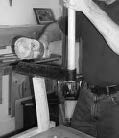Tony Peirce with two of his Windsor chars (Photo : Archives Peirce)
After more than 25 years in the pharmaceutical industry, Tony Peirce and his partner Susan Baker moved to the Eastern Townships and settled in Stanbridge East, Susan’s family homestead for more than 7 generations. Having worked with wood as a hobby for decades, Tony learned to make chairs in courses given by master craftsmen in both the USA and Canada more than ten years ago. Susan and Tony decided to create a new business called Windsor Heritage, which capitalises on both their hobbies and business skills learned throughout their careers. With the help of several local carpenters and friends, they constructed a new building, designed to be in keeping with the Georgian architecture found throughout the village.
After 3 years of planning and construction, Windsor Heritage opened its doors to the public last spring. The mission of Windsor Heritage is to provide a venue to produce and sell Windsor chairs and other arts and crafts, in an environment where customers can enjoy a coffee or light lunch and observe chairs being made by hand using 18th century tools and craftsmanship. Windsor Heritage also provides space where other local artisans can display and sell their crafts. The atelier and shop is located at 17a North Road in Stanbridge East.
Tony finds the history of chairs fascinating. Prior to the French revolution, the vast majority sat only on benches : chairs were reserved for the nobility and the very wealthy. The Windsor chair was developed during the late 17th century and named after the town of Windsor, England. English Windsor chairs were often made of elm and were usually heavy, since the best woods were used in the construction of naval ships. Artisans in North America had access to choice woods and soon more refined and lighter Windsor-styled chairs became a major export to Europe.
The delicacy of a h a n d c r a f t e d Windsor chair is possible only because the grain of the spindles, arms and bows run continuously through the parts allowing them to be shaved down by hand to as little as 3/8” in diameter. A continuous straight grain can most reliably be achieved by carefully splitting or riving the wood from a green oak, ash or hickory log using wedges and a froe. Rather than being turned, all of the parts of the back are carefully sculpted with a draw knife and spoke shave to ensure the grain is continuous throughout each piece. Once they have been sculpted, the curved parts of the back are steamed and then bent on forms to their final shape.
The seats, on the other hand, are usually made of a soft light wood, such as pine or poplar that can be deeply sculpted using a gutter adze, a scorp and a travisher to fit the body’s contours and yet keeping the chair light at the same time. The legs are usually turned from hard woods such as maple or birch and all the parts of the chair are assembled, glued and wedged.
During the 17th and 18th centuries, Windsor chairs were almost always painted, partly because of the three different kinds of woods used in construction. Tony prefers to finish the chairs with milk paint and Tung oil. It takes a full week to make a chair by hand but this produces a product that will last many generations. Tony is happy to share his knowledge and now offers chair making courses during which students learn how to sharpen and use hand tools to make their own chair.
Autres articles
Laisser un commentaire
Nous n’acceptons pas les commentaires anonymes et vous devez fournir une adresse de courriel valide pour publier un commentaire. Afin d’assumer notre responsabilité en tant qu’éditeurs, tous les commentaires sont modérés avant publication afin de nous assurer du respect de la nétiquette et ne pas laisser libre cours aux trolls. Cela pourrait donc prendre un certain temps avant que votre commentaire soit publié sur le site.
Laisser un commentaire
Avez-vous lu?
- Martine Bellavance
- Carole Dansereau, artiste en devenir
- Hélène Lessard, artiste peintre
- Maguy Carpentier, peinture et procédés mixtes
- Michel Guérin, artiste
- HOLLY SMITH GOSSELIN, ARTISTE UNDERCOVER
- CHARLES PROTEAU N’EST PAS UN ARTISTE…
- UNE ARTISTE DE LA NATURE : JULIE BELLEFROI
- HUGUES DESNOYERS ÉBÉNISTE-MENUISIER
- Groupe de rap électro-hip-hop-ludique de Frelighsburg























Superbe idée de partager votre talent. Les artistes de votre qualité sont à découvrir.
Je n’ai malheureusement pas le budget pour me petmettre un cours chez vous msis je tenterai de vous rendre visite, cette été, question de rêver un peu.
Continuez votre beau travail!
Merci beaucoup de partager avec nous.